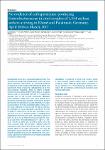No evidence of carbapenemase-producing Enterobacteriaceae in stool samples of 1,544 asylum seekers arriving in Rhineland-Palatinate, Germany, April 2016 to March, 2017
Ehlkes, Lutz
Pfeifer, Yvonne
Werner, Guido
Ignatius, Ralf
Vogt, Manfred
Eckmanns, Tim
Zanger, Philipp
Walter, Jan
Introduction: Since 2015, increased migration from Asia and Africa to Europe has raised public health concerns about potential importation of extended-spectrum β-lactamase-producing Enterobacteriaceae (ESBL-PE), specifically those producing carbapenemases (C-PE), into European hospitals.
Aims: To inform infection control practices about ESBL-PE prevalence in asylum seekers and to investigate whether C-PE prevalence exceeds that in the German population.
Methods: Cross-sectional study from April 2016–March 2017. Routinely collected stool samples from asylum seekers were tested for antibiotic resistant Enterobacteriaceae. Country/region of origin and demographic characteristics were explored as risk factors for faecal colonisation.
Results: Of 1,544 individuals, 294 tested positive for ESBL-PE colonisation (19.0%; 95% confidence intervals (CI): 17.0–21.0). Asylum seekers originating from Afghanistan/Pakistan/Iran had a prevalence of 29.3% (95% CI: 25.6–33.2), from Syria 20.4% (95% CI: 16.1–25.2) and from Eritrea/Somalia 11.9% (95% CI: 8.7–15.7). CTX-M-15 (79%) and CTX-M-27 (10%) were the most common ESBL determinants. Highest ESBL-PE prevalences were observed in boys under 10 years and women aged 20–39 years (interaction: p = 0.03). No individuals tested positive for C-PE. Faecal C-PE colonisation prevalence in asylum seekers was not statistically significantly different from prevalence reported in German communities.
Conclusion: In absence of other risk factors, being a newly arrived asylum seeker from a region with increased faecal ESBL-PE colonisation prevalence is not an indicator for C-PE colonisation and thus not a reason for pre-emptive screening and isolation upon hospital admission.
Dateien zu dieser Publikation

